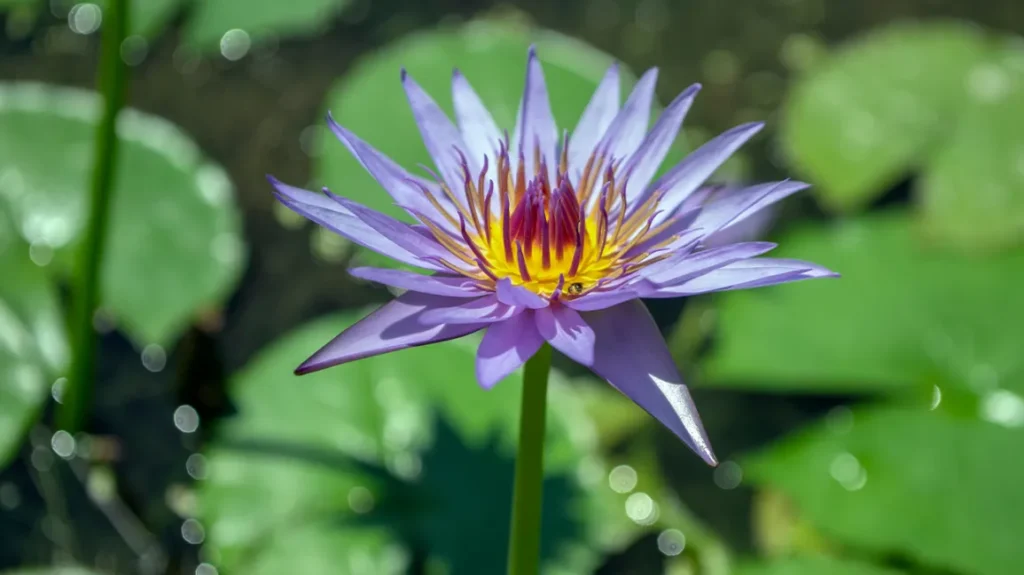The Blue Lotus Flower, scientifically known as Nymphaea caerulea, stands as a captivating aquatic plant that has enticed humanity for generations. Originating from the verdant regions of Africa and Southeast Asia, this enchanting flower boasts delicate blue petals that serenely float atop calm waters, captivating the gaze of all who behold it. Let’s delve deeper into the mystique surrounding this botanical wonder.
Historical Significance
The Blue Lotus Flower holds a significant place in various cultures and civilizations throughout history. Its presence in ancient Egyptian culture is particularly noteworthy, where it was revered as a symbol of creation and rebirth. Depictions of the flower can be found in numerous ancient Egyptian artworks, including temple walls and tombs, showcasing its importance in religious and spiritual practices.
In addition to its prominence in ancient Egypt, the Blue Lotus Flower also holds significance in Hinduism and Buddhism. In Hindu mythology, the lotus flower symbolizes purity and divine beauty, often associated with deities such as Vishnu and Lakshmi. Similarly, in Buddhism, the lotus is a symbol of enlightenment and spiritual awakening, representing the journey from darkness to light.
Botanical Characteristics
The Blue Lotus Flower belongs to the Nymphaeaceae family and is characterized by its striking blue petals and round, floating leaves. It typically grows in shallow waters, preferring ponds, marshes, and slow-moving streams. The flowers bloom during the daytime, closing at nightfall and reopening at dawn, a phenomenon that adds to their allure and mystique.
One of the most intriguing aspects of the Blue Lotus Flower is its psychoactive properties. The flower contains alkaloids such as aporphine and nuciferine, which are known to induce feelings of relaxation and euphoria when consumed. These psychoactive effects have been utilized in various traditional medicinal practices and spiritual ceremonies for centuries.
Cultural and Spiritual Significance
The Blue Lotus Flower holds deep cultural and spiritual significance in many societies around the world. In ancient Egypt, it was associated with the sun god Ra and was believed to have protective and healing properties. It was often used in religious rituals and ceremonies, as well as in the embalming process for mummification.
Similarly, in Hinduism and Buddhism, the lotus flower is revered as a sacred symbol representing purity, enlightenment, and spiritual growth. Its ability to emerge from murky waters and bloom into a beautiful flower is seen as a metaphor for the journey of the soul towards enlightenment and transcendence.
In addition to its religious and spiritual significance, the Blue Lotus Flower has also been used in traditional medicine for its various therapeutic properties. Ancient healers utilized its extracts to alleviate pain, reduce inflammation, and promote relaxation. Today, it continues to be used in herbal remedies and alternative medicine practices for its calming and mood-enhancing effects.
Modern Applications
In contemporary society, the Blue Lotus Flower continues to captivate and inspire people around the world. Its mesmerizing beauty and rich cultural history have led to its popularity as a decorative plant in gardens and water features. Additionally, its psychoactive properties have garnered interest among researchers and enthusiasts alike.
Recent studies have explored the potential therapeutic benefits of the Blue Lotus Flower, particularly in the treatment of anxiety, depression, and stress-related disorders. Preliminary research suggests that compounds found in the flower may have anxiolytic and antidepressant effects, offering a natural alternative to traditional pharmaceuticals.
Furthermore, the Blue Lotus Flower has gained popularity in the field of ethnobotany, where researchers study the cultural significance and traditional uses of plants by indigenous peoples. By documenting and preserving this knowledge, scientists hope to uncover new insights into the therapeutic properties of the flower and its potential applications in modern medicine.
Conclusion
The Blue Lotus Flower stands as a symbol of beauty, spirituality, and cultural heritage. From ancient civilizations to contemporary society, it continues to enchant and inspire people around the world with its captivating presence. As we unravel the mysteries surrounding this botanical wonder, we gain a deeper appreciation for the profound connection between nature, culture, and the human experience.







